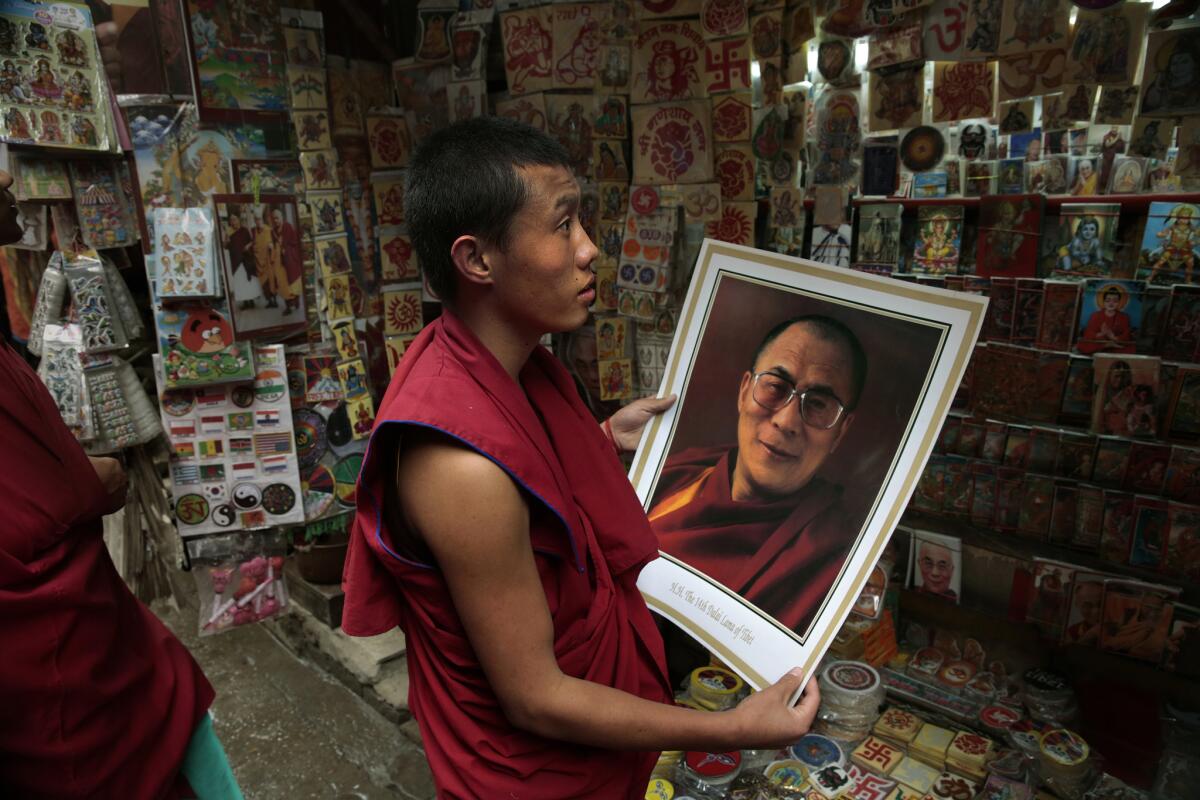Here’s the Chinese government’s step-by-step guide to becoming a ‘living Buddha’

A young monk looks at a poster of the Dalai Lama at a sidewalk stand in Dharamsala, India, on March 10, 2014.
- Share via
The Communist Party bureaucracy has managed to work its way into almost all aspects of life -- and now even the afterlife-- in China.
In order to gain greater control over Tibet, the officially atheist party has taken over the process of designating the leadership of Tibetan Buddhism -- including the next Dalai Lama. The State Religious Affairs Bureau now determines which Buddhists will be reincarnated, and more importantly, who will become a "living Buddha," an earthly incarnation of Buddha.
Buddhist spiritual leaders, of course, have their own way of explaining the process of reincarnation and the development of "teachers." But the Chinese bureaucracy is reluctant to leave things to chance--too many chances, the government worries, for imposters. In January, it was announced that an online database has been created, containing the names, photos and details of some 870 verified incarnations of Buddha.
How do you get on the list? Bureau Order No. 5 lays out the roadmap for becoming a living Buddha. Here, in 10 easy steps, is the path up the earthly ladder:
-
For any aspiring living Buddha’s community — “a majority of local religious believers” and his monastery’s management organization — must request his reincarnation (It helps to be a man, as the vast majority of Living Buddhas are).
-
He must specify his “inheritance lineage,” his connection to past lines of teachers and disciples, and this must be widely recognized as legitimate.
-
The monk must be registered to a monastery, which must be government-approved and “have the ability to train and raise living Buddhas.”
-
The monastery’s management must submit a reincarnation application to local religious authorities.
-
Those officials will review the application, then pass it on to higher authorities for approval. Monks who have a “relatively large impact” must be approved by provincial authorities; those with a “great impact” must be approved by national religious authorities; those with a “particularly great impact” must be approved at the highest levels of government.
If there’s any debate over the “size of a living Buddha’s impact,” an official Buddhist Assn. may be asked to weigh in on the matter.
-
If the reincarnation application is approved, monastery management and/or a Buddhist Assn. — one whose rank is commensurate with the monk’s importance — must establish a “ reincarnation guidance team” to search for a “reincarnate soul child.”
-
The reincarnate soul child must be reported to — and approved by — religious authorities.
-
The authorities will issue the applicant with a “living Buddha permit.”
The reincarnation may proceed.
Follow @JRKaiman on Twitter for news from Asia
ALSO:
In China, the state decides who can come back from the dead
Adult and underage workers risk their lives in Bangladesh's rising ship-breaking industry
Donkeys and women have no place in Iran's parliament, lawmaker says
Sign up for Essential California
The most important California stories and recommendations in your inbox every morning.
You may occasionally receive promotional content from the Los Angeles Times.







